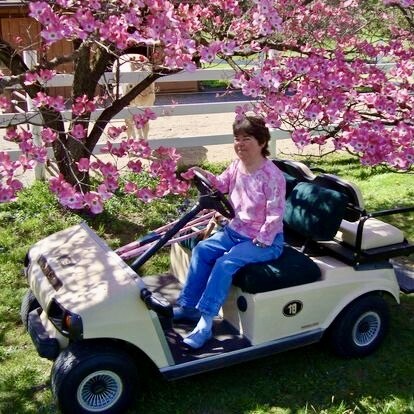Image


Towering trees, their massive trunks dark from recent rain, arched over the path. Enough sunshine filtered through the lush canopy of leaves to cast shifting pools of light upon the ground. The faint fragrance of flowers wafted on the whisper of a breeze as a bird’s trill danced through the air. Eager to explore, I pushed the forward lever on my mobility scooter and set out on the trail...
I was diagnosed with juvenile rheumatoid arthritis when I was two years old. Despite my severe physical limitations, I have always enjoyed the outdoors. Growing up on a family Christmas tree farm – I could literally go over the river (creek) and through the woods to my grandmother’s house - instilled a love of nature in me at an early age. My two older brothers created an entire world called “Miniature” down in the creek and presented summer safaris through the woods for neighbors. Driving a golf car through the fields let me enjoy my own make- believe adventures; a weeping cherry tree served as my “spy headquarters” where I hid top secret communications among the branches.
As an adult I’ve learned that nature has its own story to tell, a story I like to read and relate through the lens of my camera. Handicapped-accessible trails have allowed me to capture the beauty of the outdoors beyond my own property.
No longer just for the serious hiker, long-distance runner or avid cyclist, trails have evolved to provide outdoor recreation for people of all physical abilities. With studies suggesting that interacting with nature has health benefits, seniors and disabled people have even more reasons to hit the trails these days. Some paths are officially designated as ADA-compliant, but if in doubt, here are a few features I’ve learned make an excursion wheelchair-friendly.

A smooth, relatively flat surface is best for mobility scooters or anyone with balance issues. Gravel makes for a bumpy ride, and a dirt path can become muddy or have hidden hazards like half-buried tree roots. Asphalt or crushed stone is best.
The length of the trail is also important. The Rails-to-Trails Conservancy has created a great network of accessible avenues of exploration, but some of the routes are very long. Luckily, several trailheads allow you to do shorter segments, although you may have to go both ways on the same section (unless you have a vehicle at two access points). I prefer scenic loops, which are now being offered by many parks/arboretums.
The internet is a great source for maps showing the location of trailheads and parking. Photos posted on social media can serve as landmarks to help verify that you’re on the right path; trails of varying difficulty may intersect, and you don’t want to end up stuck on a steep hill or faced with an expanse of jagged rocks.
Park benches have been around forever, but a handy place to sit is especially important to those who are ambulatory yet need to rest often. Benches on rail trails are usually scarce, but logs or boulders will work in a pinch. More elaborate gardens offer decorative seats placed in idyllic spots that allow you to take in the beauty of your surroundings while taking a breather.
To encourage today’s youth to get outside more, some sites have added fun features. I’ve been to a farm that offers a scavenger hunt challenging visitors to find such items as a butterfly wing or a moss-covered stone. You can pretend you’re a bird at another sanctuary’s giant “nest” with low twig walls and etchings of bird feet.
I don’t need to engage in “pretend” adventures anymore; I’m able to do things that in my wildest imagination I never thought would be possible. I couldn’t wade in our creek as a child, but as an adult I can follow a winding path right to the edge of a lake. I’ve never climbed a tree, but I’ve driven my scooter into a treehouse conveniently built into an embankment. I’ve even watched hawks soar past a handicapped-accessible lookout at the top of a mountain. I can’t wait to see where the next trail will lead!

This article was previously featured in Pennsylvania Magazine.